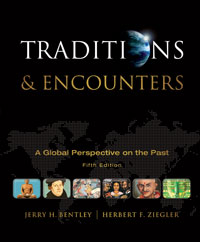1 A) test his potency and power of fertility. B) please the goddess. C) imitate the gods' sacrifice. D) be circumcised. E) None of these answers is correct. 2 A) prohibited human migrations from Siberia to North America. B) exposed land bridges that linked Siberia with Alaska, and Australia with New Guinea. C) enabled humans to migrate via floating glaciers. D) made it impossible for indigenous Americans to fish. E) All these answers are correct. 3 A) A large migration came about 13,000 B.C.E. B) By 9500 B.C.E. the migrants had reached the tip of South America. C) The migrants were hunters and gatherers. D) Most of the migrants arrived by boat. E) Most of the migrations to the Americas took place during the last ice age. 4 A) the settlers developed food crops brought from Siberia. B) horses and oxen played important roles in transportation and farming. C) the settlers developed maize as their staple food around 5000 B.C.E. D) the settlers supplemented their diets with meat from cattle. E) All these answers are correct. 5 A) established the first complex society in Mesoamerica. B) built ceremonial centers with pyramids and temples. C) lived in an area where rubber trees flourished. D) constructed elaborate drainage systems. E) All these answers are correct. 6 A) paintings that depicted the daily lives of the ruling elite. B) books on astronomy. C) huge sculptures of human heads. D) colorful murals on walls of temples. E) All these answers are correct. 7 A) civil conflicts. B) human sacrifice. C) calendric miscalculation. D) epidemics. E) None of these answers is correct. 8 A) Tikal to the Maya. B) Chichén Itzá to the Tikal. C) La Venta to the Tikal. D) Teotihuacan to the Maya. E) None of these answers is correct. 9 A) pyramids, plazas, and palaces. B) stone-paved courts for ball games. C) the Temple of the Giant Jaguar. D) kings, priests, nobles, merchants, slaves, and war captives. E) All these answers are correct. 10 A) contained a solar year and a ritual year. B) contained a twelve-year cycle. C) was devised by the kings. D) was only used to determine dates of sacrifice. E) None of these answers is correct. 11 Popol Vuh concernedA) the Maya calendar. B) the hunt for jaguars. C) the rules for the ball game. D) the creation of the world. E) None of these answers is correct. 12 A) the Pyramid of the Sun. B) the Pyramid of the Moon. C) a large quantity of books. D) iron tools. E) orange pottery. 13 A) was military pressure and invasion from surrounding peoples. B) was epidemic diseases, population pressure, and ecological destruction. C) was multiple civil wars. D) was a series of natural disasters. E) is still unknown. 14 A) the region now occupied by the states of Peru and Bolivia. B) the region now occupied by the states of Mexico, Honduras, and El Salvador. C) the islands of the Pacific Ocean. D) the region of the Amazon basin. E) All these answers are correct. 15 A) large temple complexes were built. B) carvings of wild animals were created. C) weavers produced cotton textiles. D) gold, silver, and copper jewelry was made. E) All these answers are correct. 16 A) large states of Andean society. B) large ceremonial centers of Andean society. C) large cults of the Andean region. D) gods of the Andean region. E) None of these answers is correct. 17 A) It was written down in the early centuries C.E. B) It told of contact between the Austronesians and the coastal Americans. C) It told of crossing the land bridge from southeast Asia to New Guinea. D) It told of a migration from Hawai`i to an uninhabited island. E) It told of the creation of the world. 18 A) were named after the language they spoke. B) used items made of copper and iron as items of exchange. C) spread throughout Australia. D) lived in large urban centers throughout Oceania. E) developed sea trading and communications networks. 19 A) the environments of the two islands were very different. B) the Austronesians introduced root crops and domesticated animals to New Guinea. C) the aboriginal peoples of Australia relied on kangaroo meat, which made agriculture unnecessary. D) the people of Australia converted to agriculture much earlier. E) None of these answers is correct. 20 A) their skills of navigation and boat building. B) their knowledge of agriculture and raising domestic animals. C) population pressure and internal conflicts. D) their chiefly political organizations. E) the trade network of the Lapita.





